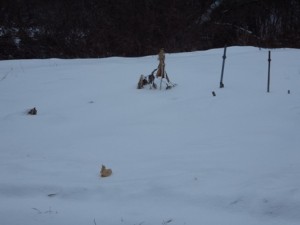 Hey, folks – welcome to February!! Up here at Chez Siberia, it’s doing its usual February thing, which means that from day to day, the morning temperature can range from minus 11 F. (which is -24C for folks across the pond) to 16 degrees F this morning (-9C). To say this sort of weather whiplash can be tough on plants is to put it mildly. As you can see from the photo, the garden at Chez Siberia is firmly under snow (though the depth is only 4-6 inches, really), and we’ve got (groundhogs notwithstanding) at least 6 weeks of snow and cold in front of us. If we get a break in March (which the long-range weather folk say we will), I’ll be able to shovel off a couple of beds in the garden, cover them with glass or clear plastic and warm them up enough (soil temps to 50 degrees F are plenty) to sow seeds from lettuce, beets, chard, and anything from the cabbage family.
Hey, folks – welcome to February!! Up here at Chez Siberia, it’s doing its usual February thing, which means that from day to day, the morning temperature can range from minus 11 F. (which is -24C for folks across the pond) to 16 degrees F this morning (-9C). To say this sort of weather whiplash can be tough on plants is to put it mildly. As you can see from the photo, the garden at Chez Siberia is firmly under snow (though the depth is only 4-6 inches, really), and we’ve got (groundhogs notwithstanding) at least 6 weeks of snow and cold in front of us. If we get a break in March (which the long-range weather folk say we will), I’ll be able to shovel off a couple of beds in the garden, cover them with glass or clear plastic and warm them up enough (soil temps to 50 degrees F are plenty) to sow seeds from lettuce, beets, chard, and anything from the cabbage family.
And speaking about veggies from the cabbage family (to be blunt – my favorite vegetable family), I’d like to draw your attention to this:
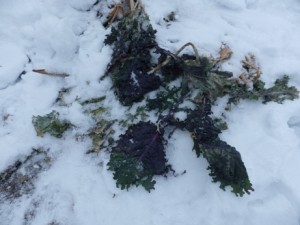 Underneath that snow are kale plants from last summer and fall. The weight of the snow and the frost caused them to flop over (usually, they stand a good 20″ tall) and get snuggled up under the snow. Why would I leave them there once the gardening ‘season’ (such as it is, here at Chez Siberia, when our first killer frost can be Sept. 30 and occasionally earlier) ended? Well, kale, especially, is cold hardy. In areas such as the Pacific Northwest, this winterhardiness factor is also found in cabbage, cauliflower, broccoli and other plants, so people actually winter garden there. They sew their seeds in September (using varieties that are super long-season), get them growing well and then once they are covered in snow, they can dig them out as the winter season progresses and they will still have fresh veggies from the garden in March. Now THAT’s what I call luxury.
Underneath that snow are kale plants from last summer and fall. The weight of the snow and the frost caused them to flop over (usually, they stand a good 20″ tall) and get snuggled up under the snow. Why would I leave them there once the gardening ‘season’ (such as it is, here at Chez Siberia, when our first killer frost can be Sept. 30 and occasionally earlier) ended? Well, kale, especially, is cold hardy. In areas such as the Pacific Northwest, this winterhardiness factor is also found in cabbage, cauliflower, broccoli and other plants, so people actually winter garden there. They sew their seeds in September (using varieties that are super long-season), get them growing well and then once they are covered in snow, they can dig them out as the winter season progresses and they will still have fresh veggies from the garden in March. Now THAT’s what I call luxury.
But back to my kale (I’m grateful for whatever I have here at this point). 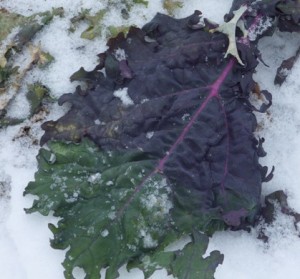 As you can see from the closeup of the leaf, this is one of the colored kales and half the leaf, because it was folded up under the plant, has gone green. It lost it’s color. The leaves on this plant literally had chunks of ice in them (I shook them free and flattened them out a bit for the photograph). The stems snapped off. These plants, to be blunt, were frozen solid and I just shoveled off the snow, broke off a few stems and made myself some sauteed kale and garlic for lunch. Tasted absolutely delightful.
As you can see from the closeup of the leaf, this is one of the colored kales and half the leaf, because it was folded up under the plant, has gone green. It lost it’s color. The leaves on this plant literally had chunks of ice in them (I shook them free and flattened them out a bit for the photograph). The stems snapped off. These plants, to be blunt, were frozen solid and I just shoveled off the snow, broke off a few stems and made myself some sauteed kale and garlic for lunch. Tasted absolutely delightful.
Actually, as a matter of fact, it tasted more than delightful. It tasted 100% better than the kale did last fall. How can THAT happen?
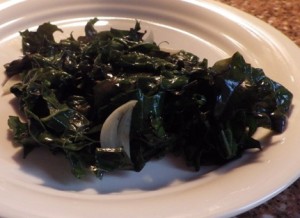 Well, the freezing process and being under the snow actually seems to take away some of the sulfur compounds in the plants which make it taste pretty spicy. This dish of kale (made the same way I always make it – rinse, remove the central stem, chop up the leaves, saute in a frying pan with olive oil and a chopped up clove of garlic) tasted…positively…sweet.
Well, the freezing process and being under the snow actually seems to take away some of the sulfur compounds in the plants which make it taste pretty spicy. This dish of kale (made the same way I always make it – rinse, remove the central stem, chop up the leaves, saute in a frying pan with olive oil and a chopped up clove of garlic) tasted…positively…sweet.
So, when you start considering what vegetables you plan to give room to this year, I’d recommend you put in some kale. Easy as pie to grow, very forgiving, and you can winter it over. Real two-fer, this one.
In other winter garden wanderings, I went up the hill to check on the fruit trees that the DH and I planted (or actually, RE-planted last fall). So far, so good. Most of what we’ve planted (despite the temperatures hovering on some nights in the super minus numbers) look pretty good.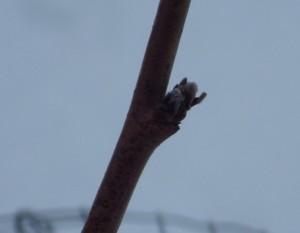 As you can see, the buds for next years growth are looking pretty decent – for the time being. Again, we have some 6 weeks and more when the weather could do damage to them.
As you can see, the buds for next years growth are looking pretty decent – for the time being. Again, we have some 6 weeks and more when the weather could do damage to them.
On the other hand, we have other damage. So far, the rabbits have not figured out how to get past the wire fencing rabbit guards that we put on all the trees (horray!). That is the good news.
The bad news, however (and this is something that, if you plant any sort of young tree, you end up having to deal with) is that the deer have decided that the ends of the new little branches of the trees are nice and tender and just what they are looking for. Deer, just as a ‘for your information’ are from the same family as goats and like goats, they will eat trees (and bushes and anything that frankly is not something like Japanese barberry), especially in the winter when their food sources are limited. Some fruit growers put pieces of paper tape (like masking tape) on the ends of all the little branches to discourage deer. I’ll have to try that, I think.
But just so you know what deer damage actually looks like:
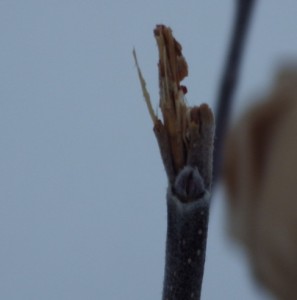 As you can see from the photo, we’ve got another bud growing right next to the chewed off part, so perhaps it won’t be so bad for this little branch. But the trick with planting fruit trees is keeping them alive (which is basically keeping the rabbits, moles and voles from chewing off the bark underneath the snow and girdling the tree which causes it to die) and hopefully keeping the fruiting branches growing. After the trees get to be five or six feet tall, then whatever nibbling the deer do is not such a big deal, but early in the development is definitely damaging to the long-term prospects of these trees.
As you can see from the photo, we’ve got another bud growing right next to the chewed off part, so perhaps it won’t be so bad for this little branch. But the trick with planting fruit trees is keeping them alive (which is basically keeping the rabbits, moles and voles from chewing off the bark underneath the snow and girdling the tree which causes it to die) and hopefully keeping the fruiting branches growing. After the trees get to be five or six feet tall, then whatever nibbling the deer do is not such a big deal, but early in the development is definitely damaging to the long-term prospects of these trees.
What winter gardening tips and secrets to you have?
